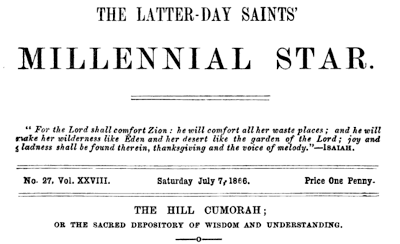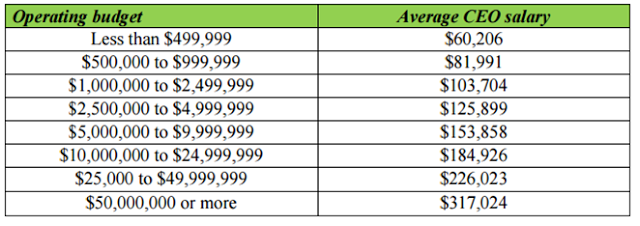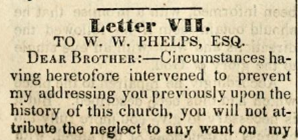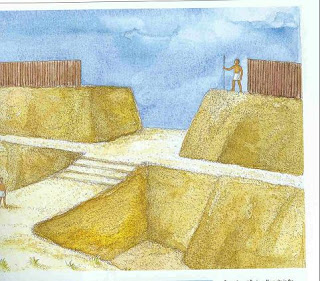False and misleading geography theories
The handful of LDS scholars who control LDS scholarly publications continue to insist that Cumorah is in Mexico, so I’m going to try again and make the issue as plain and simple as I can.
No one should be offended by this next paragraph; certainly I intend no offense by it. It’s simply a statement of fact.
If Cumorah is in New York, then every geography that puts Cumorah somewhere else is, by definition, false and misleading. This includes so-called “abstract” geographies.
There can be differences of opinion about how the New York Cumorah fits; i.e., arguments can be made about a hemispheric model (Chile to New York), a continental model (Mesoamerica to New York), or a limited geography model (Florida to New York, Iowa to New York, Pennsylvania to New York, or even all within New York).
But if Cumorah is in New York, then it can’t be anywhere else.
Which also means that any geography theory that puts Cumorah somewhere other than New York is false.
It’s that simple. And that clear.
(I’ll stipulate that if Cumorah is not in New York, then any geography that puts Cumorah in New York is itself false and misleading. I’m fine with that. IOW, everything hinges on Cumorah in New York. In my view, if Cumorah is not in New York, then it doesn’t really matter where else it is.)
_______________________
One well-known LDS scholar (whom I respect and like, so I’m not criticizing him/her) observed that “All nineteenth-century writers on Book of Mormon geography apparently assumed that the place where Joseph Smith found the plates and the hill where the Nephites met their destruction were identical.”
Now, why would they all “assume” that the Hill Cumorah was in New York?
The answer should be obvious, but apparently it’s not, so I’ll spell it out.
The first answer is Letter VII, which Oliver Cowdery wrote with the assistance of Joseph Smith. At the time, Joseph was President of the Church and Oliver was Assistant President. They wrote Letter VII as part of a series on Church history. They wrote Letter VII a few months before the Kirtland temple was completed; i.e., a few months before receiving the keys of the gathering and temple work directly from Moses, Elias, Elijah, and the Lord Himself.
So clearly (according to this handful of LDS scholars), Joseph and Oliver didn’t know what they were talking about.
(Okay, some will accuse me of sarcasm there, but this handful of scholars actually want people to believe that Joseph and Oliver didn’t know what they were talking about. They expect people to believe everything Oliver wrote, including what he transcribed as Joseph dictated and his accounts of Church history–except a few paragraphs in Letter VII that contradict their own theories. I discussed this in the lettrvii blog here.)
________________________
Our scholar continues, “Aside from this one point, however, the diversity of nineteenth-century opinion is striking.”
Actually, what is striking about that statement is the phrase, “aside from this one point.”
“This one point” is the most important point of all.
I repeat: If Cumorah is in New York, then every geography that puts Cumorah somewhere else is, by definition, false and misleading. This includes so-called “abstract” geographies.
Now, it’s completely true that there is a diversity of opinion beyond the New York location of Cumorah; as I mentioned above, there are all kinds of possibilities with Cumorah being in New York.
But Cumorah is a pin in the map that no one should remove. In my opinion.
________________________
The second reason why all of Joseph’s contemporaries accepted the New York setting for Cumorah is that Mormon’s depository was there.
So far as I can tell, every LDS scholar accepts Mormon 6:6.
6 And it came to pass that when we had gathered in all our people in one to the land of Cumorah, behold I, Mormon, began to be old; and knowing it to be the last struggle of my people, and having been commanded of the Lord that I should not suffer the records which had been handed down by our fathers, which were sacred, to fall into the hands of the Lamanites, (for the Lamanites would destroy them) therefore I made this record out of the plates of Nephi, and hid up in the hill Cumorah all the records which had been entrusted to me by the hand of the Lord, save it were these few plates which I gave unto my son Moroni.
Everyone agrees that Cumorah was Moron’s depository.
Wherever that depository is, that’s where Cumorah is.
We have multiple accounts of Joseph and Oliver visiting this repository in the Hill Cumorah in New York. The most cited is Brigham Young’s account given in a special conference in Farmington, Utah, in 1877. It’s in the Journal of Discourses here, and I’ve written about it before, so I won’t repeat that. By now, everyone should know what he said. If you don’t, go to the link and read it for yourself. I’ll mention another thing he said on that occasion in the next section below. Several others corroborated what Brigham said.
Separately from Brigham Young’s account, the July 7, 1866, edition of The Latter-Day Saints’ Millennial Star ran a front-page article by Orson Pratt titled “The Hill Cumorah: Or the Sacred Depository of Wisdom and Understanding.” I wrote a post about this on the lettervii blog.
___________________
In my opinion, there are no legitimate reasons for rejecting Letter VII and the many corroborating evidences for the New York Cumorah. So why is this handful of LDS scholars so adamant about doing so?
The only answer I’ve come up with so far is tradition and training.
This handful of LDS scholars have all learned from the same people, who in turn learned from the people who learned from the originators of the two-Cumorah theory and the limited geography Mesoamerican theory.
(Readers tell me they want me to name names, but personalities are beside the point and they’re distracting because people apparently get offended when they are named. This is not about the people; it’s about the theories. The origins, merits, and repercussions of the theories are what matter, not who came up with them originally or is perpetuating them today. It doesn’t matter to me whether it is a professor or a Sunday School teacher or a home teacher who is perpetuating these theories; you need to understand what matters most. If you’re in a situation where someone is talking about Book of Mormon geography, ask if they accept the New York Cumorah or not. Their answer will tell you what you need to know. You may get a response to the effect that “I don’t have an opinion.” If that’s the case, then they shouldn’t be saying anything about the geography at all, beyond explaining the issues; i.e., they should tell you about Letter VII and how a small group of LDS scholars rejects what Oliver Cowdery wrote, while others accept it, and so on. If they don’t know about Letter VII, but they still teach anything about geography, then educate them.)
I know how alluring the two-Cumorah and related ideas are. I was taught them myself, and I believed them for many years. But they are fundamentally inconsistent with what Joseph and Oliver taught, and how can anyone living today know more about the topic than Joseph and Oliver?
Not to mention, what Joseph and Oliver taught makes more sense than the modern theories anyway.
I’m working on a chapter about the origins of the two-Cumorah theory that contains some quite surprising material that I didn’t know until I dug into it. I think you’ll like it. Maybe I’ll post the chapter, or portions of it, on the new blog.
In the meantime, I want to end with this excerpt from Brigham Young’s sermon in Farmington. It comes after he spoke about the depository. Remember, he said about the depository that “I take this liberty of referring to those things so that they will not be forgotten and lost.” But to the handful of scholars who reject the New York Cumorah (and those who listen to them and perpetuate their teachings), the things Brigham Young taught are definitely forgotten and lost. (Or, worse, explained away as a vague vision of a mountain in Mexico.)
Brigham next spoke about the the foolishness of seeking after gold and silver instead of paying attention “to the legitimate business that God has given them to perform.” People were spending time and money seeking treasure by mining, but Brigham said “what they did get was just sufficient to allure them.”
The geography theories that put Cumorah anywhere but New York remind me of that. There’s just enough to be alluring, but they are an enormous waste of time and effort and money.
Here’s what Brigham said:
The Lord has permitted our enemies to come among us, who would destroy us if they could. They are only allowed to allure the minds of the foolish and those who lack judgment and who know not the things of God. But when we, as individuals and as a people, learn things as they are, we will find this fact—all truth is worthy and worth possessing, while all untruth is not worthy nor worth running after, nor working for, nor spending our lives for. The Gospel of life and salvation which God has revealed to us, incorporates all the systems there are. Every true principle and every true science, and every truth there is, are incorporated within the faith of the Latter-day Saints. This is something worth possessing, this is worth spending our time for; but the religions of the day, independent of their moral worth, are nothing but a myth, a shadow; there is no reality in them.
Based on past experience, no doubt someone will be offended that I republished Brigham’s statement in this context. If you’re offended, don’t be. This isn’t directed at you. I’ve explained before that I think this whole Mesoamerican thing originated with the overzealous efforts of a guy Joseph described as having a “rotten heart,” who “would injure the Church as much as he could.” Instead, let’s take another look and get back to the origins.
In my view, we can rely on Joseph and Oliver.
Source: Book of Mormon Wars










